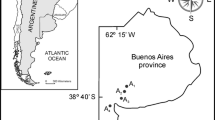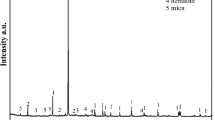Abstract
This study investigated the desorption behavior of heavy metals, Zn(II) and Cu(II), in the contaminated soil using citric acid and citric acid-containing wastewater (CACW). Four influence factors, including soil contamination levels, dosage of citric acid, reaction time and soil pH were taken into account. Using the citric acid, the desorption reaction with heavy metals was rapid (i.e., less than 2 h). The removal percentage of Zn(II) and Cu(II) reached more than 90% for one type of Suzhou clay with a pH value of 6.58 and a contaminated level of Zn > 2.7 mg/g and Cu > 3.3 mg/g. The increase of soil pH inhibited the metal desorption. The desorption behavior predicted by Visual MINTEQ was in good agreement with the experimental results. The desorption behavior of Zn(II) and Cu(II) was governed by the affinity of sorption sites for heavy metals and the chelating of organic ligands. Soil contamination levels and contact time were investigated when using CACW as the desorbent. It was concluded that CACW was also effective in extracting Zn(II) and Cu(II) from soil surface. When the contact time between CACW and contaminated soil reached 2 h, the removal percentage of Zn(II) and Cu(II) increased to 33% and 60%, respectively. As a result, CACW that is usually treated as a waste product can be a promising washing solution for soil remediation.









Similar content being viewed by others
References
Tang Q, Kim HJ, Endo K, Katsumi T, Inui T (2015) Size effect on lysimeter test evaluating the properties of construction and demolition waste leachate. Soils Found 55(4):720–736
McGrath SP, Zhao FJ, Lombi E (2001) Plant and rhizosphere process involved in phytoremediation of metal-contaminated soils. Plant Soil 232:207–214
McKeehan P (2000) Brownfields: the Financial, Legislative and Social Aspects of the Redevelopment of Contaminated Commercial and Industrial Properties. http://www.csa.com/discoveryguides/brown/overview.php. Accessed 11 Feb 15
Wei CY, Chen TB (2001) Hyperaccumulators and phytoremediation of heavy metal contaminated soil: a review of studies in China and abroad. Acta Ecol Sin 21:1196–1203
Tang Q, Zhang Y, Gao YF, Gu F (2017) Use of cement-chelated solidified MSWI fly ash for pavement material: mechanical and environmental evaluations. Can Geotech J 54(11):1553–1566
Mohammed SAS, Sanaulla PF, Moghal AAB (2016) Sustainable use of locally available red earth and black cotton soils in retaining Cd 2+, and Ni 2+, from aqueous solutions. Int J Civ Eng 14:1–15
Tang Q, Gu F, Gao YF, Inui T, Katsumi T (2017) Desorption characteristics of Cr(III), Mn(II) and Ni(II) in contaminated soil using citric acid and citric acid containing wastewater. Soils Foun (JGS). https://doi.org/10.1016/j.sandf.2017.12.001
Tang Q, Tang XW, Hu MM, Li ZZ, Chen YM, Lou P (2010) Removal of Cd(II) from aqueous solution with activated firmiana simplex leaf: behaviors and affecting factors. J Hazard Mater 179:95–103
Rahman MM, Asaduzzaman M, Naidu R (2013) Consumption of arsenic and other elements from vegetables and drinking water from an arsenic-contaminated area of Bangladesh. J Hazard Mater 262:1056–1063
Tang Q, Tang XW, Li ZZ, Wang Y, Hu MM, Zhang XJ, Chen YM, Zn(II (2012) Removal with activated firmiana simplex leaf: kinetics and equilibrium studies. J Environ Eng 138(2):190–199
Rodrigues SM, Cruz N, Coelho C, Henriques B, Carvalho L, Duarte AC, Pereira E, Romkens PFAM. (2013) Risk assessment for Cd, Cu, Pb and Zn in urban soils: chemical availability as the central concept. Environ Pollut 183:234–242
Tang Q, Tang XW, Li ZZ, Chen YM, Kou NY, Sun ZF (2009) Adsorption and desorption behaviour of Pb(II) on a natural kaolin: equilibrium, kinetic and thermodynamic studies. J Chem Technol Biotechnol 84:1371–1380
Karkush MO, Resol DA (2017) Remediation of sandy soil contaminated with industrial wastewater. Int J Civ Eng 15:441–449
Damaraju M, Bhattacharyya D, Kurilla KK (2017) Removal of recalcitrant carbon from an industrial wastewater using electrocoagulation. Int J Civ Eng 15:697–703
Moon DH, Lee JR, Wazne M, Park JH (2012) Assessment of soil washing for Zn contaminated soils using various washing solutions. J Ind Eng Chem 18:822–825
Gu YY, Yeung AT (2011) Desorption of cadmium from a natural shanghai clay using citric acid industrial wastewater. J Hazard Mater 191:144–149
Römkens P, Bouwman L, Japenga J, Draaisma C (2002) Potentials and drawbacks of chelate-enhanced phytoremediation of soils. Environ Pollut 116:109–121
Jean L, Bordas F, Bollinger JC (2007) Chromium and nickel mobilization from a contaminated soil using chelants. Environ Pollut 147:729–736
Dhillon GS, Brar SK, Verma M, Tyagi RD (2011) Recent advances in citric acid bio-production and recovery. Food Bioprocess Technol 4:505–529
Li CL, Yang HL, Xia XL, Li YJ, Chen LP, Zhang M, Zhang L, Wang W (2013) High efficient treatment of citric acid effluent by Chlorella vulgaris and potential biomass utilization. Biores Technol 127:248–255
Tang Q, Katsumi T, Inui T, Li ZZ (2015) Influence of pH on the membrane behavior of bentonite amended Fukakusa clay. Sep Purif Technol 141:132–142
Zhi X, Yang H, Berthold S, Doetsch C, Shen J (2010) Potential improvement to a citric wastewater treatment plant using biohydrogen and a hybrid energy system. J Power Sources 195:6945–6953
Tang Q, Wang HY, Tang XW, Wang Y (2016) Removal of aqueous Ni(II) with carbonized leaf powder: kinetic and equilibrium studies. J Cent South Univ 23:778–786
Tang Q, Liu Y, Gu F, Zhou T (2016) Solidification/stabilization of fly ash from a municipal solid waste incineration facility using Portland cement. Adv Mater Sci Eng 2016:10. https://doi.org/10.1155/2016/7101243 (Article ID 7101243)
Tang Q, Zhou T, Gu F, Wang Y, Chu JM (2017) Removal of Cd(ІІ) and Pb(ІІ) from soil through desorption using citric acid: kinetic and equilibrium studies. J Cent South Univ 24:1941–1952
Tang Q, Katsumi T, Inui T, Li ZZ (2014) Membrane behavior of bentonite-amended compacted clay. Soils Found 54:329–344
Tang Q, Chu J, Wang Y, Zhou T, Liu Y (2016) Characteristics and factors influencing Pb (ii) desorption from a chinese clay by citric acid. Sep Sci Technol 51(17):2734–2743
Li ZZ, Tang Q, Katsumi T, Tang XW, Inui T, Imaizumi S (2010) Leaf char: an alternative adsorbent for Cr(III). Desalination 264:70–77
Xu HN, Yang JR (1995) The absorption of Cd and the cation exchange capacity of the root system. Agro Environ Protect 4:150–153 (in Chinese)
Qin F, Shan XQ, Wei B (2004) Effects of low-molecular-weight organic acids and residence time on desorption of Cu, Cd, and Pb from soils. Chemosphere 57:253–263
Pagnanelli F, Esposito A, Toro L, VegliO` F (2003) Metal speciation and pH effect on Pb, Cu, Zn and Cd biosorption onto Sphaerotilus natans: Langmuir-type empirical model. Water Res 37:627–633
Sun WL, Zhao R, Zhang L, Deng BS, Ni JR (2001) Effect of pH on copper sorption by the loess and its species. Chin J Environ Sci 22:78–83 (in Chinese)
Xu YH, Zhao DY (2005) Removal of copper from contaminated soil by use of poly (amidoamine) dendrimers. Environ Sci Technol 39:2369–2375
Wu LH, Luo YM, Christie P, Wong MH (2003) Effects of EDTA and low molecular weight organic acids on soil solution properties of a heavy metal polluted soil. Chemosphere 50:819–822
He HP (2001) Studies on the interaction of clayed mineral and metallic ions. Petrolic Industrial Press, Beijing
Falamaki A, Tavallali H, Eskandari M, Farahmand SR (2016) Immobilizing some heavy metals by mixing contaminated soils with phosphate admixtures. Int J Civ Eng 14(2):75–81
Wang Y, Tang XW, Chen YM, Zhan LT, Li ZZ, Tang Q (2009) Adsorption behavior and mechanism of Cd(II) on loess soil from China. J Hazard Mater 172:30–37
Wang DZ, Jiang X, Rao W, He JZ (2009) Kinetics of soil cadmium desorption under simulated acid rain. Ecol Complex 6:432–437
Li ZZ, Tang XW, Chen YM, Wang Y (2009) Sorption behavior and mechanism of Pb(II) on Chinese loess. J Environ Eng 135:58–67
Zhang M (2005) Adsorption of heavy metal ions in soil. Shanxi Water Resour 1:84–90 (in Chinese)
Yee N (2001) Experimental studies of adsorption in bacteria–water–rock systems: implications for heavy metal transport in the subsurface. Ph.D. Dissertation, University of Notre Dame, Indiana
Lu YL, Song S, Wang RS, Liu ZY, Meng J, Sweetman AJ, Jenkins A, Ferrier RC, Li H, Luo W, Wang TY (2015) Impacts of soil and water pollution on food safety and health risks in China. Environ Int 77(1):5–15
Loganathan P, Vigneswaran S, Kandasamy J, Naidu R (2012) Cadmium sorption and desorption in soils: a review. Crit Rev Environ Sci Technol 42:489–533
Zhao XL, Jiang T, Du B (2014) Effect of organic matter and calcium carbonate on behaviors of cadmium adsorption–desorption on/from purple paddy soils. Chemosphere 99:41–48
Yang JY, Yang XE, He ZL, Li TQ, Shentu JL, Stoffella PJ (2006) Effects of pH, organic acids, and inorganic ions on lead desorption from soils. Environ Pollut 143:9–15
Chen YX, Lin Q, Luo YM, He YF, Zhen SJ, Yu YL, Tian GM, Wong MH (2003) The role of citric acid on the phytoremediation of heavy metal contaminated soil. Chemosphere 50:807–811
Smith RM, Martell RM (1977) Critical stability constants. In: Other organic ligands, vol 3. Plenum Press, New York
O¨ren AH, Kaya A (2006) Factors affecting adsorption characteristics of Zn2+ on two natural zeolites. J Hazard Mater B131:59–65
Jopony M, Young SD (1994) The solid–solution equilibria of lead and cadmium in polluted soils. Eur J Soil Sci 45:59–70
Naidu R, Kookana RS, Sumner ME, Harter RD, Tiller KG (1997) Cadmium sorption and transport in variable charge soils: a review. J Environ Qual 26:602–617
James RO, Healy TW (1972) Adsorption of hydrolysable metal ions at the oxide–water interface III. A thermodynamic model of adsorption. J Colloid Interface Sci 40:65–81
Moutsatsou A, Gregou M, Matsas D, Protonotarios V (2006) Washing as a remediation technology applicable in soils heavily polluted by mining–metallurgical activities. Chemosphere 63:1632–1640
Lange NA (2005) Lange’s Handbook of Chemistry[M], 16th edn. McGraw-Hill Press, USA
Sun B, Zhao FJ, Lombi E, McGrath SP (2001) Leaching of heavy metals from contaminated soils using edta. Environ Pollut 113:111–120
Torres LG, Lopez RB, Beltran M (2012) Removal of As, Cd, Cu, Ni, Pb, and Zn from a highly contaminated industrial soil using surfactant enhanced soil washing. Phys Chem Earth 37:30–36
Acknowledgements
The research presented herein is financially supported by the National Nature Science Foundation of China (51708377), Natural Science Foundation of Jiangsu Province (BK20170339), China Postdoctoral Science Foundation funded project (2016M591756), Natural Science Fund for Colleges and Universities in Jiangsu Province (17KJB560008), Jiangsu Planned Projects for Postdoctoral Research Funds (1601175C), Jiangsu Provincial Department of Housing and Urban–Rural Development (2016ZD18, 2017ZD002), Jiangsu Provincial Transport Bureau (2016T05), and Six Talent Peaks Project in Jiangsu, China (2015-JNHB-018).
Funding
Not Applicable.
Author information
Authors and Affiliations
Corresponding author
Rights and permissions
About this article
Cite this article
Gu, F., Zhang, Y., Tang, Q. et al. Remediation of Zn(II)- and Cu(II)-Contaminated Soil Using Citric Acid and Citric Acid-Containing Wastewater. Int J Civ Eng 16, 1607–1619 (2018). https://doi.org/10.1007/s40999-018-0300-5
Received:
Revised:
Accepted:
Published:
Issue Date:
DOI: https://doi.org/10.1007/s40999-018-0300-5




